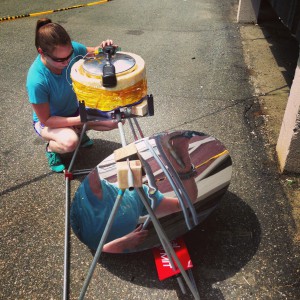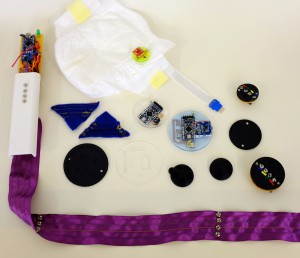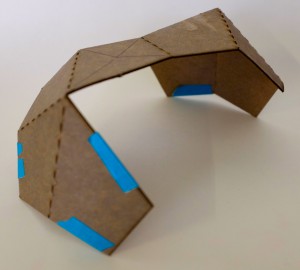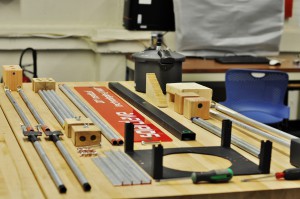
Researcher Anna Young of MIT's Little Devices Lab works on a solar-powered autoclave for sterilizing medical instruments
(Image: Jose Gomez-Marquez)
“It’s a robot…it brings the remote.”
A kid in a striped shirt who looks to be going into the second or third grade reluctantly explains his cardboard and foam creation, a boxy figure with four wheels and a grabbing arm. He’s taken his invention from paper design through model through an imagined cover of TIME magazine, joined by countless other children who have designed everything from rockets to surprisingly detailed wind turbines.
I’m at the MIT Museum, and today it is overrun with inventors. Upstairs, younger visitors are invited to invent and model their own creations—like the remote-getting robot—and downstairs people gather to see presentations and prototypes by students working in MIT labs. This event is Insight into Innovation, the mad invention of the museum’s summer interns, and it’s a natural fit for MIT’s Little Devices Lab, a medical research group with a do-it-yourself twist whose offices are right above the museum. Three groups from that lab are exhibiting.
Wearable Health’s color-coded biosensors, embedded in buttons, read things like movement, temperature and skin conductivity, an indicator of anxiety and other emotional and physiologic states. They are decorative accessories that can be easily clipped to clothing and beam the biometric data to the wearer’s iPhone.
Another group takes a different angle: stations placed throughout a city where ordinary people can take free biometric measurements with the convenience of an ATM. The stations, called M-PULSE and designed in collaboration with MIT architecture students, would give people who ordinarily don’t have access to health technology the opportunity to measure their own blood pressure, pulse, EKG and other health-related data. The stations could email the results to users and aggregate the data to form portraits of how healthy the neighborhoods are overall.A project called Solarclave seeks to bring medical instrument sterilization to developing countries without access to a supply chain. Its student inventors noticed that essential medical technologies are difficult to maintain and repair outside of established infrastructure, so they designed a solar-powered autoclave—an inexpensive, easy to construct device that sterilizes by raising pressure and temperature. Their first sterilization container was housed within a plastic bucket, and their materials were color-coded for easy construction without any instructions necessary.
The team took a prototype to Nicaragua, where they discovered what worked—and what didn’t. The plastic bucket was a problem: It looked similar to the buckets locals used to dispose of trash. As incoming Dartmouth freshman Ian Speers puts it, “Even though this wasn’t the case, it appeared that the sterilization device was in a trash can. Which is not good.” The enclosure in version 2.0 looked more like a metal pressure cooker.All of the projects are likely to go through further iterations. In interactive booths, eager attendees provide valuable information for the inventors as they attempt to construct part of Solarclave without instructions, try out an M-PULSE station and toy with the buttons from Wearable Health.
“People just came up and told us everything that was bad about it,” says George Tall, a rising senior at Northwestern who works on Wearable Health. “The negative feedback was very helpful—it wasn’t fully functioning, but people could comment on the construction or the perceived usability of it.”
Jose Gomez-Marquez, who leads the Little Devices Lab, emphasizes the value of this exchange when I talk to him later: “Sometimes users will give you silly feedback, but sometimes they’ll give you feedback that you simply would have not encountered otherwise,” he says. “This week we’re going to debrief with the students to see what it is that people gave them.”
For now, though, the students focus on explaining their projects as the attendees touch and try out others’ inventions, make their own or just take in exhibits and soak in the atmosphere. The boy with the remote-getting robot hands it off to a parent and reaches to touch a solar-powered mobile in the gift shop, wondering how it’s put together.
The inspiration goes both ways, says Gomez-Marquez: “The best outcome that we can get from an event like this, or from any of our technologies, is a phone call from somebody who says, ‘You know, I made my own, and this is what I made.’ That’s what makes it really exciting.”










